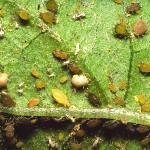Aphid, Melon
Aphis gossypii
Identification:
Aphids found in cucurbits include green peach aphid and melon aphid. Melon aphid has a wide host range; vegetable crops attacked include cucurbits, asparagus, pepper, eggplant and okra. Among cucurbits, it is more serious on cucumber, muskmelon and watermelon than in squash and pumpkins. Varieties differ in susceptibility. The cornicles at tip of abdomen are always black, a key diagnostic feature. Melon aphid outbreaks are more common in hot, dry weather.
Life Cycle:
Melon aphid overwinters in the north on woody plants including catalpa and rose of sharon; more southerly, adults survive on cold tolerant plants including spinach and dock. Life cycle is similar to green peach aphid; winged females colonize crops in early summer, and wingless females produce live young for about 15 days (70-80 offspring per female) resulting in multiple generations. The time from birth to reproductive adult can be one week. Wingless females are 1-2 mm long. Color varies from light green mottled with dark green (most common) to white, yellowish or dark green.
Crop Injury:
Infestations occur on undersides of leaves where aphids extract plant sap with their piecing sucking mouthparts. Feeding causes yellowing, puckering, leaf curling, and leaf death at high numbers along with shiny honeydew deposits and buildup of sooty mold. Viruses transmitted by melon aphid include cucumber mosaic, watermelon mosaic, and zucchini yellow mosaic. Because transmission occurs within 15 seconds of feeding, insecticides may not prevent initial virus infection though they may reduce its spread in the crop. Oils may reduce virus transmission but test for phytotoxicity.
Monitoring & Thresholds:
Scout for aphids beginning in mid June by searching undersides of leaves on runners. If 20 percent of runners or more have live aphids treatment may be needed. Good coverage of undersides of leaves is needed for control.
Cultural Controls & Prevention:
- Cultivars differ in susceptibility to aphid buildup and to virus; plant resistant varieties if they are available.
- Use row covers or reflective plastic mulch to prevent early infestation and virus transmission (direct seeding is recommend in reflective mulch for maximum effectiveness).
- Separate early and late plantings.
- Use selective insecticides for other pests to conserve natural enemies.
For current information on production methods (including varieties, spacing, seeding, and fertility), weed, disease, and insect management, please visit the New England Vegetable Management Guide website.
Biological Controls:
In general, aphid predators are better at controlling high aphid populations, compared to parasitoids, as they are not as efficient at finding low numbers of aphids within the crop.
Ladybeetles are effective at controlling high aphid populations but are highly dispersive and will leave the tunnel in search of food if aphid populations are too low. They can be effective if released under row cover in winter greens. Adults and larvae feed on a wide variety of aphid species.
Predatory midges (Aphidoletes aphidimyza) are another generalist aphid predator that can be purchased and released in your tunnel. They are active in summer months but when day lengths shortens to less than 15 hours (September-March), they enter diapause and become inactive. Larvae feed on aphids and adults feed on pollen and aphid honeydew. Banker plants used to support Aphidius colemani will also support Aphidoletes midges. The midges pupate in the soil, so place banker plants in a tray with moist sand to provide pupation sites if your tunnel has plastic mulch and weed mat.
Green lacewing larvae also feed on many aphid species. Adults feed on pollen and nectar. Lacewings can be purchased as eggs or larvae; larvae tend to survive better than eggs. Release far apart from each other, as larvae are cannibalistic. In summer months, if temperatures rise above 95°F, lacewings will move out of the tunnel. Lacewing activity and life cycle slows as temperature drops, but one report from Purdue University reported that adults remained active and laying eggs at 52°F.
Crops that are affected by this insect:
The Center for Agriculture, Food and the Environment and UMass Extension are equal opportunity providers and employers, United States Department of Agriculture cooperating. Contact your local Extension office for information on disability accommodations. Contact the State Center Director’s Office if you have concerns related to discrimination, 413-545-4800 or see ag.umass.edu/civil-rights-information.
